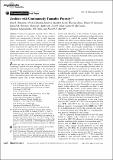Files in this item
Zeolites with continuously tuneable porosity
Item metadata
| dc.contributor.author | Wheatley, Paul S | |
| dc.contributor.author | Chlubná-Eliášová, Pavla | |
| dc.contributor.author | Greer, Heather | |
| dc.contributor.author | Zhou, Wuzong | |
| dc.contributor.author | Seymour, Valerie R | |
| dc.contributor.author | Dawson, Daniel M | |
| dc.contributor.author | Ashbrook, Sharon E | |
| dc.contributor.author | Pinar, Ana B | |
| dc.contributor.author | McCusker, Lynne B | |
| dc.contributor.author | Opanasenko, Maksym | |
| dc.contributor.author | Cejka, Jiří | |
| dc.contributor.author | Morris, Russell E | |
| dc.date.accessioned | 2014-12-09T13:01:01Z | |
| dc.date.available | 2014-12-09T13:01:01Z | |
| dc.date.issued | 2014-11-24 | |
| dc.identifier | 157246176 | |
| dc.identifier | e578171f-cc94-4612-b63c-2c050292ed80 | |
| dc.identifier | 25284344 | |
| dc.identifier | 84915746264 | |
| dc.identifier | 000345317000040 | |
| dc.identifier.citation | Wheatley , P S , Chlubná-Eliášová , P , Greer , H , Zhou , W , Seymour , V R , Dawson , D M , Ashbrook , S E , Pinar , A B , McCusker , L B , Opanasenko , M , Cejka , J & Morris , R E 2014 , ' Zeolites with continuously tuneable porosity ' , Angewandte Chemie , vol. 126 , no. 48 , pp. 13426-13430 . https://doi.org/10.1002/ange.201407676 | en |
| dc.identifier.issn | 0044-8249 | |
| dc.identifier.other | ORCID: /0000-0002-4538-6782/work/56638980 | |
| dc.identifier.other | ORCID: /0000-0001-9752-7076/work/58055062 | |
| dc.identifier.other | ORCID: /0000-0002-8110-4535/work/34029117 | |
| dc.identifier.other | ORCID: /0000-0001-7809-0315/work/61622135 | |
| dc.identifier.uri | https://hdl.handle.net/10023/5906 | |
| dc.description | Funding: Royal Society for provision of an industry fellowship and the EPSRC for funding (EP/K025112/1 and EP/L014475/1) (R.E.M.); Czech Science Foundation for (P106/12/G015) (J.Cˇ.); European Community under a Marie Curie Intra-European Fellowship (A.B.P.). | en |
| dc.description.abstract | Zeolites are important materials whose utility in industry depends on the nature of their porous structure. Control over microporosity is therefore a vitally important target. Unfortunately, traditional methods for controlling porosity, in particular the use of organic structure-directing agents, are relatively coarse and provide almost no opportunity to tune the porosity as required. Here we show how zeolites with a continuously tuneable surface area and micropore volume over a wide range can be prepared. This means that a particular surface area or micropore volume can be precisely tuned. The range of porosity we can target covers the whole range of useful zeolite porosity: from small pores consisting of 8-rings all the way to extra-large pores consisting of 14-rings. | |
| dc.format.extent | 5 | |
| dc.format.extent | 812630 | |
| dc.language.iso | eng | |
| dc.relation.ispartof | Angewandte Chemie | en |
| dc.subject | ADOR | en |
| dc.subject | Germanosilicates | en |
| dc.subject | Porosity | en |
| dc.subject | Zeolites | en |
| dc.subject | QD Chemistry | en |
| dc.subject | BDC | en |
| dc.subject | R2C | en |
| dc.subject.lcc | QD | en |
| dc.title | Zeolites with continuously tuneable porosity | en |
| dc.type | Journal article | en |
| dc.contributor.sponsor | EPSRC | en |
| dc.contributor.sponsor | EPSRC | en |
| dc.contributor.institution | University of St Andrews. School of Chemistry | en |
| dc.contributor.institution | University of St Andrews. EaSTCHEM | en |
| dc.identifier.doi | https://doi.org/10.1002/ange.201407676 | |
| dc.description.status | Peer reviewed | en |
| dc.identifier.url | https://onlinelibrary.wiley.com/doi/10.1002/ange.201407676#support-information-section | en |
| dc.identifier.url | https://onlinelibrary.wiley.com/doi/full/10.1002/anie.201407676 | en |
| dc.identifier.grantnumber | EP/K025112/1 | en |
| dc.identifier.grantnumber | EP/L014475/1 | en |
This item appears in the following Collection(s)
Items in the St Andrews Research Repository are protected by copyright, with all rights reserved, unless otherwise indicated.

